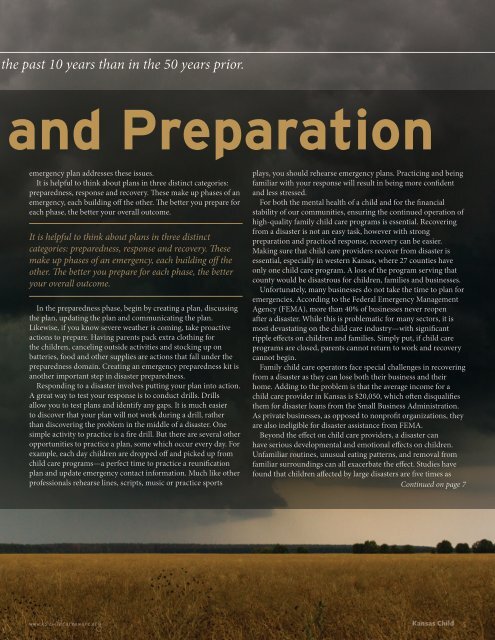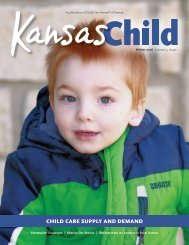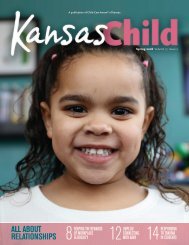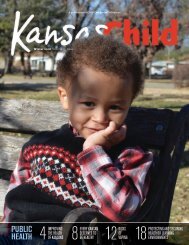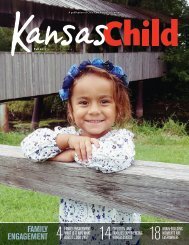2017 Spring Kansas Child
Emergency Preparedness
Emergency Preparedness
Create successful ePaper yourself
Turn your PDF publications into a flip-book with our unique Google optimized e-Paper software.
the past 10 years than in the 50 years prior.<br />
and Preparation<br />
emergency plan addresses these issues.<br />
It is helpful to think about plans in three distinct categories:<br />
preparedness, response and recovery. These make up phases of an<br />
emergency, each building off the other. The better you prepare for<br />
each phase, the better your overall outcome.<br />
It is helpful to think about plans in three distinct<br />
categories: preparedness, response and recovery. These<br />
make up phases of an emergency, each building off the<br />
other. The better you prepare for each phase, the better<br />
your overall outcome.<br />
In the preparedness phase, begin by creating a plan, discussing<br />
the plan, updating the plan and communicating the plan.<br />
Likewise, if you know severe weather is coming, take proactive<br />
actions to prepare. Having parents pack extra clothing for<br />
the children, canceling outside activities and stocking up on<br />
batteries, food and other supplies are actions that fall under the<br />
preparedness domain. Creating an emergency preparedness kit is<br />
another important step in disaster preparedness.<br />
Responding to a disaster involves putting your plan into action.<br />
A great way to test your response is to conduct drills. Drills<br />
allow you to test plans and identify any gaps. It is much easier<br />
to discover that your plan will not work during a drill, rather<br />
than discovering the problem in the middle of a disaster. One<br />
simple activity to practice is a fire drill. But there are several other<br />
opportunities to practice a plan, some which occur every day. For<br />
example, each day children are dropped off and picked up from<br />
child care programs—a perfect time to practice a reunification<br />
plan and update emergency contact information. Much like other<br />
professionals rehearse lines, scripts, music or practice sports<br />
plays, you should rehearse emergency plans. Practicing and being<br />
familiar with your response will result in being more confident<br />
and less stressed.<br />
For both the mental health of a child and for the financial<br />
stability of our communities, ensuring the continued operation of<br />
high-quality family child care programs is essential. Recovering<br />
from a disaster is not an easy task, however with strong<br />
preparation and practiced response, recovery can be easier.<br />
Making sure that child care providers recover from disaster is<br />
essential, especially in western <strong>Kansas</strong>, where 27 counties have<br />
only one child care program. A loss of the program serving that<br />
county would be disastrous for children, families and businesses.<br />
Unfortunately, many businesses do not take the time to plan for<br />
emergencies. According to the Federal Emergency Management<br />
Agency (FEMA), more than 40% of businesses never reopen<br />
after a disaster. While this is problematic for many sectors, it is<br />
most devastating on the child care industry—with significant<br />
ripple effects on children and families. Simply put, if child care<br />
programs are closed, parents cannot return to work and recovery<br />
cannot begin.<br />
Family child care operators face special challenges in recovering<br />
from a disaster as they can lose both their business and their<br />
home. Adding to the problem is that the average income for a<br />
child care provider in <strong>Kansas</strong> is $20,050, which often disqualifies<br />
them for disaster loans from the Small Business Administration.<br />
As private businesses, as opposed to nonprofit organizations, they<br />
are also ineligible for disaster assistance from FEMA.<br />
Beyond the effect on child care providers, a disaster can<br />
have serious developmental and emotional effects on children.<br />
Unfamiliar routines, unusual eating patterns, and removal from<br />
familiar surroundings can all exacerbate the effect. Studies have<br />
found that children affected by large disasters are five times as<br />
Continued on page 7<br />
www.ks.childcareaware.org <strong>Kansas</strong> <strong>Child</strong> 5


